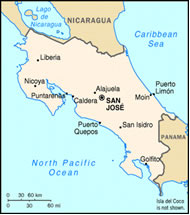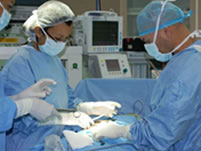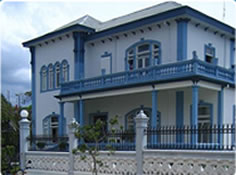| Home > Costa Rica |
COSTA RICA:
Country Profile of Costa Rica
Costa Rica, or Republic of Costa Rica, is an independent country in Central America. The name is Spanish for “Rich Coast.”
|
☻Capital: - San José ☻Area: - Total: 51,100 kmē (128th) 19,730 sq mi ☻Independence: - from Spain (via Guatemala): September 14th, 1821 |
☻Official languages: - Spanish ☻Population: - July 2007 Estimate : 4,133,884 (119th) - Density: 85/km² (107th) 220/sq mi |
Geography of Costa Rica:
 Costa Rica lies between Nicaragua to the north and Panama to the south and faces both the Caribbean Sea and the Pacific Ocean. With an area of 19,730 square miles (51,100 km2), Costa Rica ranks after El Salvador as the smallest republic in Central America. It also comprises several islands. Cocos Island stands out because of its distance from continental landmass, but Calero Island is the largest island of the country.
Costa Rica lies between Nicaragua to the north and Panama to the south and faces both the Caribbean Sea and the Pacific Ocean. With an area of 19,730 square miles (51,100 km2), Costa Rica ranks after El Salvador as the smallest republic in Central America. It also comprises several islands. Cocos Island stands out because of its distance from continental landmass, but Calero Island is the largest island of the country.Costa Rica’s geography is small, yet diverse. From lush rainforest to paradise on tropical beaches to active volcanoes, the country offers a variety of interesting destinations. An astonishing five percent of the world's biodiversity is found here, including more than 800 species of ferns, 1,000 of orchids, 2,000 kinds of trees, and 200 species of mammals. Geographically, the country can be divided into four regions: the highlands, the Pacific coast, the Caribbean coast and the tropical rainforest. The highlands consist of a mountain chain that runs through the center of Costa Rica from Nicaragua to Panama. The west coast borders the Pacific Ocean, The east coast runs along the Caribbean Sea. The tropical rainforest is found in the lowlands on either side of the mountain chain.
The capital, San Jose, rests roughly in the nation's center, settled within a highland valley. Cascading down to the Caribbean from the central mountains are Costa Rica's many great rivers, including the Reventazon. The Pacific side is marked by two broad peninsulas that hook out into the Pacific, the Nicoya and the Osa.
Costa Rica's climate is renowned as an atmospheric treat. Mild subtropical conditions prevail year-round, and discomforting temperature extremes and prolonged periods of gray are practically nonexistent. Temperature varies mainly according to elevation, the higher the cooler. The brunt of the rainy season lasts from May through November, while a brief dry spell pays a visit from February to April. Costa Rica's rain falls mainly on the Caribbean coast, giving the Pacific a much more arid climate.
Demonstrating an environmental sensitivity unparalleled elsewhere, Costa Ricans have set aside one quarter of their land as protected areas and national parks. Ecotourists are rewarded with botanical and animal marvels found nowhere else on Earth. Although Costa Rica is best known as an invaluable refuge for nature, this small nation is also a haven of peace.
Education in Costa Rica:
 The literacy rate in Costa Rica is at 95%, one of the highest in Latin America. Many of the country’s early fathers like the first president, Jose Maria Castro, were former teachers who were concerned about the education in Costa Rica. In 1869, the country became one of the first in the world to make the education both free and obligatory, funded by the state’s share of the great coffee wealth. In those days only one in ten Costa Ricans could read and write. By 1920; 50% of the population were literate and by 1970s 89% were able to read and write.
The literacy rate in Costa Rica is at 95%, one of the highest in Latin America. Many of the country’s early fathers like the first president, Jose Maria Castro, were former teachers who were concerned about the education in Costa Rica. In 1869, the country became one of the first in the world to make the education both free and obligatory, funded by the state’s share of the great coffee wealth. In those days only one in ten Costa Ricans could read and write. By 1920; 50% of the population were literate and by 1970s 89% were able to read and write.The last 20 years have seen a significant boosts to educational standards. Elementary and High schools are to be found in every community. Universal public education is guaranteed in the constitution. Primary education is obligatory, and both preschool and high school are free. There are both state and private universities.Students are not required to pay for assistance, a nominal charge of around $20 per year applies. Elementary school has 6 year levels, where as high school has 5 year levels. Each is divided in two cycles, and upon completion of each cycle, students are required to pass tests on all subjects studied during those years. The most notorious of these tests are the Bachillerato Tests. Students are required to get the high school diploma needed for admission to Universities.
Libraries are the only way for adults in rural areas to continue education beyond six grade. The country, with approximately 100 libraries, has a desperate need for books and for funds to support the hundreds of additional libraries that the country needs.
Health in Costa Rica:
 In Costa Rica sanitary standards are high and the health system is excellent. Statistics from the World Health Organization's "The World Health Report 1995" place Costa Rica third, in life expectancy in the world.Certainly, some reasons for this can be found in the Costa Rican laid back lifestyle, the healthy, fresh, non-preservative laden foods of the country, the tropical climate, but ultimately Costa Rica seems to be a healthy place to live and is considered to have one of the best health care systems in all of Latin America
In Costa Rica sanitary standards are high and the health system is excellent. Statistics from the World Health Organization's "The World Health Report 1995" place Costa Rica third, in life expectancy in the world.Certainly, some reasons for this can be found in the Costa Rican laid back lifestyle, the healthy, fresh, non-preservative laden foods of the country, the tropical climate, but ultimately Costa Rica seems to be a healthy place to live and is considered to have one of the best health care systems in all of Latin AmericaWith a government sponsored network, of 29 hospitals and more than 250 clinics, throughout the country, the Caja Costarricense de Seguro Social (CCSS) has primary responsibility for providing low cost, health services, to the Costa Rican population. Each year thousands of men and women from overseas take advantage of the low-cost, high-quality care provided by Costa Rica's cosmetic surgeons and dentists.
Several private hospitals in San Jose also offer emergency medical services to foreigners are reasonable prices: Clinica Biblica (avenida 14, calles central & 1, tel. 223-6422) also has a 24-hour pharmacy. Costa Rica's Social Security system (the Caja) offers a medical insurance assistance program for foreigners needing emergency medical assistance. The coverage can be bought at travel agencies, language schools or through tour companies.
Politics in Costa Rica:
 Costa Rica is a democratic republic, as defined by the 1949 Constitution, which guarantees all citizens and foreigners equality before the law, the right to own property, the right of petition and assembly, freedom of speech, and the right to habeas corpus. As in the United States, the government is divided into independent executive, legislative, and judicial branches, with "separation of powers" .Executive responsibilities are vested in a president, who is the country's center of power. There also are two vice presidents and a 15 member cabinet.
Costa Rica is a democratic republic, as defined by the 1949 Constitution, which guarantees all citizens and foreigners equality before the law, the right to own property, the right of petition and assembly, freedom of speech, and the right to habeas corpus. As in the United States, the government is divided into independent executive, legislative, and judicial branches, with "separation of powers" .Executive responsibilities are vested in a president, who is the country's center of power. There also are two vice presidents and a 15 member cabinet.Autonomous state agencies enjoy considerable operational independence; they include the telecommunications and electrical power monopoly, the state petroleum refinery, the nationalized commercial banks, the state insurance monopoly, and the social security agency. Costa Rica has no military and maintains only domestic police and security forces for internal security. A professional Coast Guard was established in 2000.
Costa Rica has long emphasized the development of democracy and respect for human rights. Until recently, the country's political system has contrasted sharply with many of its Central American neighbours; it has steadily developed and maintained democratic institutions and an orderly, constitutional scheme for government succession. Several factors have contributed to this tendency, including enlightened government leaders, comparative prosperity, flexible class lines, educational opportunities that have created a stable middle class, and high social indicators. Also, because Costa Rica has no armed forces, it has avoided the possibility of political intrusiveness by the military that other countries in the region have experienced.